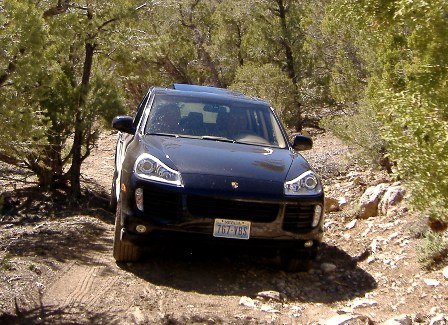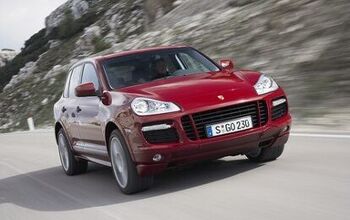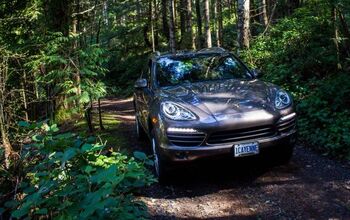2008 Porsche Cayenne Review

"The Porsche Cayenne is a deeply misunderstood machine," RF told me before my test drive. "It's one of the world's fastest off-roaders, not a house-broken truck." Huh? Why would a world famous sports car maker (if not THE world famous sports car maker) tempt infamy by making a kick-ass mud plugger instead of a FX-style sports-car-on-stilts? The answer, I'm told, lies deep in Porsche's DNA. In the late eighties, Porsche jacked-up their 959 supercar and entered it in the grueling Paris – Dakar rally. In their second attempt, the German automaker scooped first, second and sixth places. "Take the entry level V6 off road," RF commanded. "Thrash it without mercy. THEN tell me what you think." Sounded like a plan.
So, as the concierge squealed around the corner, he gunned the Cayenne's engine. An attractive V6 rasp echoed off the concrete parking garage walls at the Wynn Las Vegas. Crisply creased with unnaturally angry Porsche eyes, the Midnight Black Metallic model created a strong initial impression. And then, it turned towards the side, and I shuddered. The Cayenne's rear is displeasingly plump and oddly rounded. The new blacked-out glass at the bottom of the rear window is a rare example of Porsche de-evolution; its angularity makes a bad design worse.
Our tester's interior was overwhelmingly beige. Only a black center stack– with a stereo face from 1986– relieved the Saharan color scheme. Sisters VW Touareg and Audi Q7 both have the Cayenne licked in terms of switchgear, material choices and general cabin appeal. That Porsche can still offer a vehicle at this price point without Bluetooth or iPod connectivity is testimony to the brand's snob appeal, rather than Porsche's ability to compete head-on with its upmarket peers.
Once you get used to the Cayenne's monotone color scheme and lack of toys, you begin to appreciate Stuttgartian subtleties. The Cayenne's buttons, knobs, and dials may be annoyingly small and fiddly, but they're all ideally situated for performance-oriented pilots. Better yet, there's nothing overly-complicated to distract you the business at hand– although saddling-up on expensive options might solve that "problem."
On the road, the base Cayenne proved stable and agile, just like the much cheaper VW Touareg. The Porsche's 3.6-liter direct injection 290bhp V6 motivated the 4949 lbs. truck adequately; the zero to 60 sprint takes only 7.5 seconds. Porsche tuned the exhaust to mimic their flat sixes, but they only receive a participation ribbon in that regard.
The Cayenne's long pedal travel and delayed throttle response added to the building suspicion I was driving an expensive VW, not a [relatively] cheap Porsche. The Cayenne's mileage-seeking tranny always started in second gear, guaranteeing a take-off reminiscent of a Wagoneer (or an over-loaded 727). You can select first gear from the Tiptronic. In traffic, that gets old real quick.
In general, on road, the Cayenne feels like it was designed with only a vague memory of the 911, as if the icon were a faded poster in the closet of the Porsche SUV department.
Leaving Las Vegas, I headed to Tikaboo Valley. Rumbling over the guard rail entrance to the 22.5 mile trail, I doubted Porsche's lumbering lummox could redeem itself. By the end of the first mile, I was looking in the glove box for a Papal dispensation.
The Cayenne's delayed throttle response made power modulation on bumps and sand a doddle; I could feed the six the perfect amount of gas at the perfect pace. Porsche Traction Management and the Cayenne's steel spring multi-link suspension made short work of washboard surfaces, deep sand, scree and dead jackrabbits. Flying down dirt roads, the Cayenne's six-speed transmission was always in the right gear. I was no longer a prat with a Bluetooth earpiece; I was Stig Blomqvist in the Dakar.
The harder and faster you pushed the Cayenne on the fast dirt sections, the more sure-footed it became. The Cayenne is as unflappable in the dirt as a Cayman is on the track. In the really rough sections, the Cayenne's low-range with the lockable differentials allowed absurd bouldering shenanigans. Climbing to the top of Tikaboo Peak, the Cayenne could do no wrong.
Mission accomplished. Point taken. The Porsche Cayenne, even in its simplest form, embodies all the passion and engineering skill of a 911. But it's a fervor rooted in the deserts, plains and mountains of Africa, not the middle of the Nürburgring. The Cayenne's fast and fun on dirt roads, and poised and capable scrambling over river washes and steep climbs. It's a damn shame the vast majority of Cayenne owners will never discover this vehicle's true essence. Because otherwise, cash cow or not, the Cayenne makes no sense.

More by Mike Solowiow
Latest Car Reviews
Read moreLatest Product Reviews
Read moreRecent Comments
- ToolGuy First picture: I realize that opinions vary on the height of modern trucks, but that entry door on the building is 80 inches tall and hits just below the headlights. Does anyone really believe this is reasonable?Second picture: I do not believe that is a good parking spot to be able to access the bed storage. More specifically, how do you plan to unload topsoil with the truck parked like that? Maybe you kids are taller than me.
- ToolGuy The other day I attempted to check the engine oil in one of my old embarrassing vehicles and I guess the red shop towel I used wasn't genuine Snap-on (lots of counterfeits floating around) plus my driveway isn't completely level and long story short, the engine seized 3 minutes later.No more used cars for me, and nothing but dealer service from here on in (the journalists were right).
- Doughboy Wow, Merc knocks it out of the park with their naming convention… again. /s
- Doughboy I’ve seen car bras before, but never car beards. ZZ Top would be proud.
- Bkojote Allright, actual person who knows trucks here, the article gets it a bit wrong.First off, the Maverick is not at all comparable to a Tacoma just because they're both Hybrids. Or lemme be blunt, the butch-est non-hybrid Maverick Tremor is suitable for 2/10 difficulty trails, a Trailhunter is for about 5/10 or maybe 6/10, just about the upper end of any stock vehicle you're buying from the factory. Aside from a Sasquatch Bronco or Rubicon Jeep Wrangler you're looking at something you're towing back if you want more capability (or perhaps something you /wish/ you were towing back.)Now, where the real world difference should play out is on the trail, where a lot of low speed crawling usually saps efficiency, especially when loaded to the gills. Real world MPG from a 4Runner is about 12-13mpg, So if this loaded-with-overlander-catalog Trailhunter is still pulling in the 20's - or even 18-19, that's a massive improvement.






































Comments
Join the conversation
I'm not sure I understand the Cayenne criticism. It is an SUV ... and a pretty dang good one at that. No, it's not a sports car. But all of you who complain that Cayenne owners will never take it off road, how many of you have taken your 911s or Caymans on the track? How many of you have actually driven your Porsche faster than 100 mph ... for extended periods of time? I owned a C4 and had the pleasure of regularly "cruising" the autobahn at 150 mph. Now, I have a family and live in the snowbelt. A C4 isn't practical, so now I have a Cayenne. Add in the fact that Porsche has made a enough money on these to keep the company not only in the black but expand its holdings in VW, and I think Cayenne has been good for Porsche.
Unless it isn't.